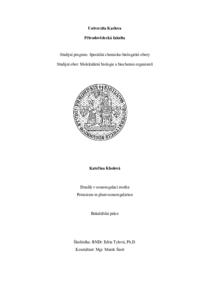Draslík v osmoregulaci rostlin
Potassium in plant osmoregulation
bakalářská práce (OBHÁJENO)

Zobrazit/
Trvalý odkaz
http://hdl.handle.net/20.500.11956/109008Identifikátory
SIS: 170563
Katalog UK: 990022927580106986
Kolekce
- Kvalifikační práce [20357]
Autor
Vedoucí práce
Konzultant práce
Šustr, Marek
Oponent práce
Konrádová, Hana
Fakulta / součást
Přírodovědecká fakulta
Obor
Molekulární biologie a biochemie organismů
Katedra / ústav / klinika
Katedra experimentální biologie rostlin
Datum obhajoby
5. 9. 2019
Nakladatel
Univerzita Karlova, Přírodovědecká fakultaJazyk
Čeština
Známka
Dobře
Klíčová slova (česky)
draslík, transport, osmoregulace, turgor, průduchyKlíčová slova (anglicky)
potassium, transport, osmoregulation, turgor, stomataDraslík je v rostlině velmi mobilní a je čile transportován přes membrány, za pomoci transportérů a kanálů. Vyskytuje se v rostlině výhradně ve formě iontu K+. Rovněž ve formě tohoto iontu je přijímán z půdního roztoku a to pomocí transportéru HAK5 a kanálu AKT1. Kanál SKOR a transportér KUP7 zprostředkovává přenos K+ do xylému. Klíčová je role draslíku jako osmoticky aktivního prvku, který reguluje množství vody v buňkách a tím i udržování turgoru, nezbytného pro udržení tvaru rostlinné buňku a její růst. Jako modelový systém pro popis procesů souvisejících s osmotickou funkcí K+ se rozšířilo využití průduchů. V průduchách, totiž pohyb K+ umožňuje regulaci otevírání a zavírání apertury na principu změn turgoru. Do svěracích buněk zajišťují transport K+ kanály KAT1, KAT2, AKT1 a AKT2, odvod K+ naopak obstarává kanál GORK na plazmatické membráně a TPK1 na tonoplastu. Draslík také podporuje transport asimilátů ve floému, v čemž hraje roli kanál AKT2. Právě osmotické funkce K+ jsou hlavním tématem této bakalářské práce, která shrnuje aktuální poznatky o transportních mechanismech K+ nezbytných pro funkci K+ jako osmoticky aktivní látky.
Potassium is very mobile in plants and is transported across membranes using transporters and channels. It is present in the ionic form K+ in plants. Also, in the form of this ion, K+ is taken up by plants from the soil solution. The uptake is mediated by the transporter HAK5 and by the channel AKT1. The transfer of K+ to the xylem is provided by the channel SKOR and the transporter KUP7. The role of potassium as an osmotically active element is crucial. K+ helps to regulate the amount of water in the cells and thus to maintain the turgor. Turgor is important for maintaining the shape of the plant cells and for its growth. Stomatal guard cells are used as a model system for describing processes related to the K+ osmotic function. Movement of K+ is involved in the regulation of opening and closing of stomata on the principle of turgor changes. Transport of K+ into guard cells is provided by channels KAT1, KAT2, AKT1 and AKT2. On the contrary, K+ release is mediated by the channel GORK on the plasma membrane and TPK1 on the tonoplast. K+ supports also the transport of assimilates in the phloem, where the channel AKT2 plays a role. The osmotic functions of K+ are the main topic of this bachelor thesis, which summarizes current knowledge about transport mechanisms necessary for the function of K+ as osmotically...
